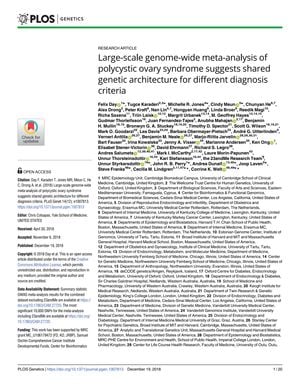TLDR The research found that PCOS has common genetic factors regardless of how it is diagnosed and is linked to metabolic and reproductive issues.
The study conducted a genome-wide meta-analysis involving 10,074 PCOS cases and 103,164 controls to explore the genetic basis of polycystic ovary syndrome (PCOS) across different diagnostic criteria. It identified 14 genetic loci associated with PCOS, including three new loci, and found that the genetic architecture was consistent across different diagnostic criteria, with only one locus differing significantly. The study also revealed genetic correlations between PCOS and metabolic traits, menopause, depression, and male-pattern balding, suggesting shared biological pathways. Mendelian randomization analysis indicated that BMI and fasting insulin levels might be causal risk factors for PCOS. The findings support the hypothesis that PCOS has a common genetic basis underlying different phenotypes and is related to both metabolic and reproductive disorders.
 133 citations
,
February 2017 in “PLoS Genetics”
133 citations
,
February 2017 in “PLoS Genetics” Genetic factors can help predict male pattern baldness risk.
 47 citations
,
June 2016 in “JAMA Dermatology”
47 citations
,
June 2016 in “JAMA Dermatology” Men with early hair loss have similar hormone levels to women with PCOS, possibly increasing risk of obesity and heart issues.
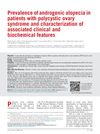 48 citations
,
February 2014 in “Fertility and Sterility”
48 citations
,
February 2014 in “Fertility and Sterility” Women with PCOS often have hair loss, which is linked to acne or excess body hair but not to worse hormone or metabolic issues.
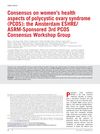 1514 citations
,
December 2011 in “Fertility and sterility”
1514 citations
,
December 2011 in “Fertility and sterility” Experts agree that PCOS affects women's health in complex ways, but more research is needed to understand and treat it effectively.
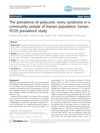 215 citations
,
January 2011 in “Reproductive Biology and Endocrinology”
215 citations
,
January 2011 in “Reproductive Biology and Endocrinology” About 7% to 15% of Iranian women have polycystic ovary syndrome, depending on the criteria used to diagnose it.
 4809 citations
,
January 2004 in “Fertility and Sterility”
4809 citations
,
January 2004 in “Fertility and Sterility” The 2003 consensus updated PCOS diagnosis criteria and highlighted increased risks of diabetes and heart disease for those affected.
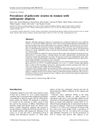 84 citations
,
November 2003 in “European journal of endocrinology”
84 citations
,
November 2003 in “European journal of endocrinology” Women with androgenic alopecia are more likely to have polycystic ovaries and higher androgen levels, which may indicate PCOS.
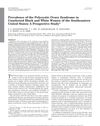 633 citations
,
September 1998 in “The Journal of Clinical Endocrinology and Metabolism”
633 citations
,
September 1998 in “The Journal of Clinical Endocrinology and Metabolism” PCOS affects a similar percentage of Black and White women in the Southeastern United States.
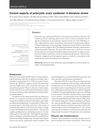 15 citations
,
December 2016 in “Revista Da Associacao Medica Brasileira”
15 citations
,
December 2016 in “Revista Da Associacao Medica Brasileira” Polycystic ovary syndrome is a common hormonal disorder in women, linked to increased risk of metabolic and heart diseases, and needs more research for better understanding and treatment.
 10 citations
,
January 2011 in “Skin therapy letter”
10 citations
,
January 2011 in “Skin therapy letter” Women with PCOS often have acne because of high androgen levels, and the article reviewed how to treat this type of acne.
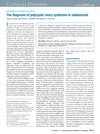 212 citations
,
May 2010 in “American Journal of Obstetrics and Gynecology”
212 citations
,
May 2010 in “American Journal of Obstetrics and Gynecology” Diagnosing PCOS in teenagers is challenging and should use strict criteria to avoid misdiagnosis and unnecessary worry.
 4809 citations
,
January 2004 in “Fertility and Sterility”
4809 citations
,
January 2004 in “Fertility and Sterility” The 2003 consensus updated PCOS diagnosis criteria and highlighted increased risks of diabetes and heart disease for those affected.
